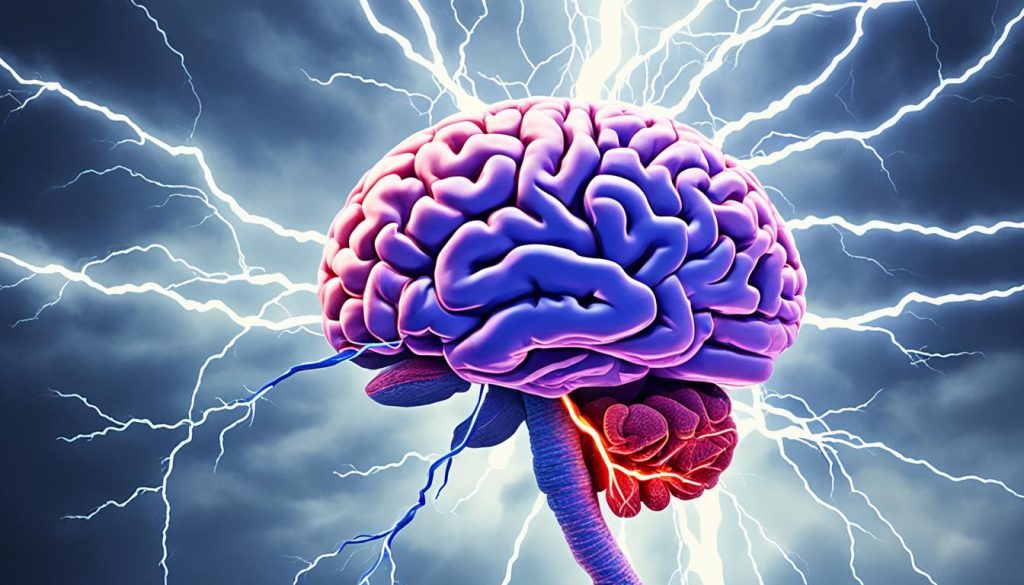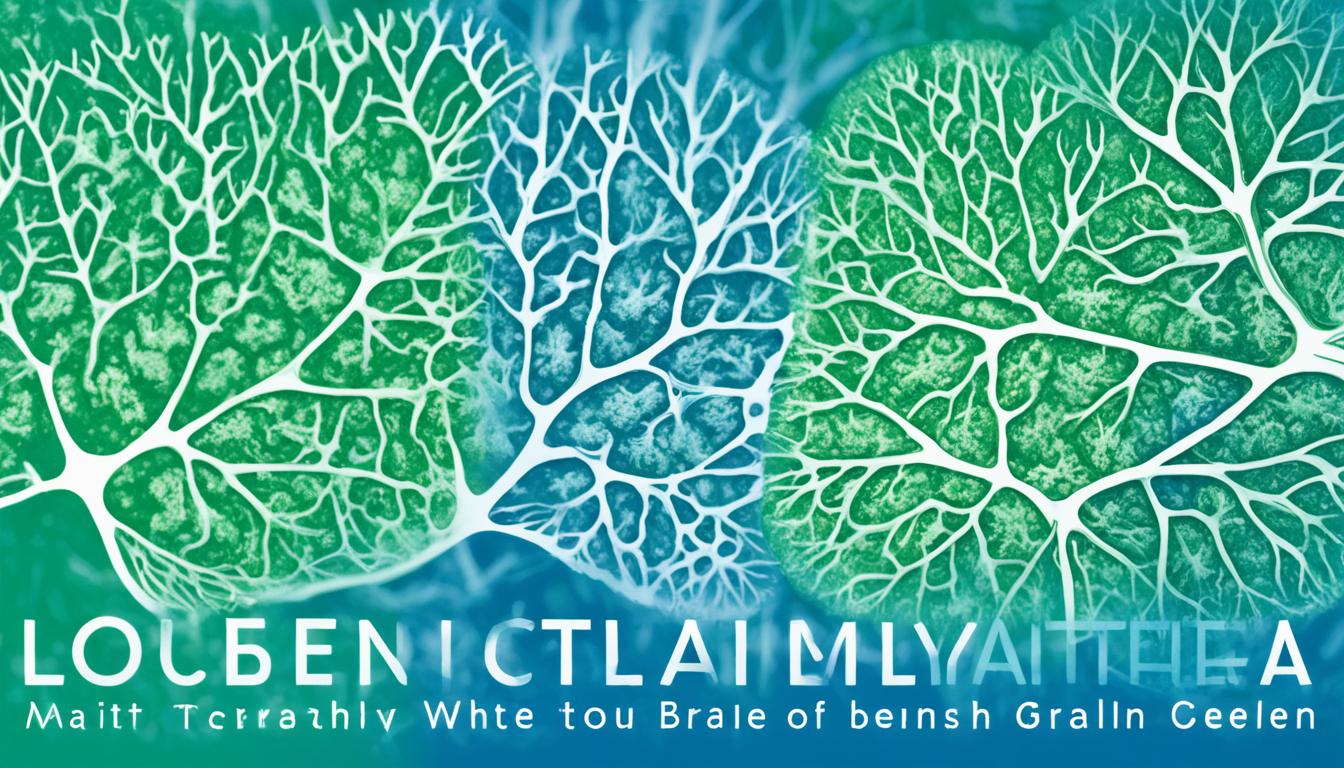Adrenoleukodystrophy (ALD) is a rare genetic disorder. It affects the nervous system’s white matter and the adrenal cortex. People with ALD have too many very long-chain fatty acids (VLCFAs) in their bodies.
This leads to damage to the myelin sheath and nerve cell problems. Symptoms can include thinking issues, trouble moving, and not enough adrenal hormones. In severe cases, it can even lead to death. Metachromatic leukodystrophy and Krabbe disease are similar conditions.
Key Takeaways:
- Adrenoleukodystrophy (ALD) is a rare genetic disorder affecting the nervous system and adrenal cortex.
- ALD is characterized by the accumulation of very long-chain fatty acids (VLCFAs) in the body.
- Symptoms of ALD include cognitive decline, motor disabilities, adrenal insufficiency, and more.
- Other leukodystrophies similar to ALD include Metachromatic leukodystrophy and Krabbe disease.
- ALD is classified as a rare neurological disease.
Diagnosis of Adrenoleukodystrophy
The diagnosis of Adrenoleukodystrophy (ALD) includes looking at symptoms, medical history, and tests. Doctors use different ways to diagnose it. Here’s what they usually do:
- Blood testing: A key step is blood tests. These measure very long-chain fatty acids (VLCFAs) in the blood. High VLCFA levels point to ALD.
- Genetic testing: Genetic tests check the ABCD1 gene for issues. This gene causes ALD. The test confirms the diagnosis and shows the risk for others in the family.
- MRI scans: MRI scans look for brain issues and nerve damage. They can show detailed brain images, helping diagnose ALD.
- Vision screening: Vision checks are vital, especially for at-risk males who don’t have other symptoms yet. These tests pick up early signs of the disease.
- Skin biopsy and fibroblast cell culture: Sometimes, skin and cell tests are needed. They check for high VLCFA in skin cells. This backs up the ALD diagnosis.
Using these tools, doctors can pinpoint Adrenoleukodystrophy. This early detection allows for better care and disease management.
Treatment of Adrenoleukodystrophy
Currently, there’s no cure for ALD. But, treatment options can help reduce symptoms and slow the disease.
Stem Cell Transplant
Stem cell transplant is a promising treatment for ALD. Physicians replace diseased stem cells with healthy ones. Doing this early can halt or slow the disease. It helps by bringing VLCFAs to normal levels and protecting the myelin sheath.
Adrenal Insufficiency Treatment
Adrenal insufficiency is a common issue with ALD. It’s when glands don’t make enough hormones, leading to tiredness and low blood sugar. Corticosteroids like hydrocortisone or prednisone can help by replacing these hormones.
Medications
Doctors may also use medications to treat ALD symptoms. For instance, antispasmodic drugs and anti-seizure pills can help control muscle stiffness and seizures. This makes life better by reducing pain.
Physical Therapy
Physical therapy is key in managing ALD. It targets muscle issues, boosts movement, and keeps function at its best. Therapists create exercises to improve skills. Sometimes, using walking aids is advised to help with mobility.
Gene Therapy
Gene therapy is a new hope for ALD, especially cerebral ALD in the early stages. It puts a healthy copy of the ABCD1 gene into the patient’s cells. The goal is to slow down the disease and save brain function. Studies continue to see how safe and effective gene therapy is over time.
Care at Mayo Clinic for Adrenoleukodystrophy
Mayo Clinic focuses on top-notch care for those with adrenoleukodystrophy (ALD). They have a team who are very good at what they do and use the latest technology. This means they can give a full check-up, find out what’s wrong, and help manage the health concerns ALD brings.
Expert teams at Mayo Clinic include genetics, neurology, and endocrinology specialists. They work together to find and watch ALD closely.
They use special machines like MRI to see how much nerve damage there is. Then, they make a plan with different types of care, from stem cell transplants to physical therapy. They think about each person’s symptoms, how the disease is moving, and their overall health. This makes the care personal and just right for each patient.
Mayo Clinic also works on new treatments through research and trials. They give support to both patients and their families. This help includes learning materials and counseling to guide them through the ALD journey.
If you or someone you know needs help with ALD, Mayo Clinic is a great choice. Their skilled team will do everything they can to help. They aim to offer the best care possible, supporting those with ALD along the way.
Requesting an Appointment at Mayo Clinic
To set up an appointment, just contact Mayo Clinic by phone or online. They make it easy to get the care you need. Their team will help pick the best date and time for you.
Adrenoleukodystrophy Information and Support
Getting the right info is key for those affected by adrenoleukodystrophy. The National Institute of Neurological Disorders and Stroke and Genetics Home Reference are good sources. They offer a lot of information on what causes it, its symptoms, and how to treat it.
If you’re looking to connect with others dealing with the same situation, support groups are a great way. They provide a space to share stories and get answers. The Transplants support group on Mayo Clinic Connect is one example. It lets you find people with similar challenges related to adrenoleukodystrophy.
Getting good information and connecting with support groups can make a big difference. They help you understand the issue better, provide emotional support, and face the struggles together.
Cerebral Adrenoleukodystrophy (CALD)
Cerebral adrenoleukodystrophy (CALD) is a severe type of ALD affecting the brain, mainly in children. It strikes about 1 in 21,000 boys aged 4 to 10. CALD builds up very long-chain fatty acids (VLCFAs) in the brain. This leads to the loss of myelin, resulting in quick cognitive and motor skill decline.
Untreated, CALD can be deadly within four to eight years. But, if caught early, outcomes from treatments like stem cell transplants and gene therapy are promising. They help stop or slow the brain damage, allowing children to lead better lives.
Adrenomyeloneuropathy (AMN)
Adrenomyeloneuropathy (AMN) falls under Adrenoleukodystrophy (ALD) and mainly impacts males. It typically starts in late teens or adulthood. Its key signs are worsened leg movement, odd walking, feeling of no sensation, ache, and problems with controlling the bladder and bowels. Men may also experience issues like not being able to achieve or keep an erection and losing their hair sooner than expected.
As for treatment, the focus is to ease symptoms and better life quality. This often involves therapies, drugs, and care tailored to the patient’s needs.
| Symptoms | Progression | Treatment |
|---|---|---|
|
|
|
Addison’s Disease in Adrenoleukodystrophy
ALD can cause adrenal insufficiency, or Addison’s disease. This means the adrenal glands don’t make enough hormones. This leads to symptoms like feeling tired, losing weight, nausea, or low blood pressure.
Treatment involves taking corticosteroids to replace the missing hormones. This brings necessary hormones back to normal levels for health.
| Symptoms of Addison’s Disease | Treatment for Addison’s Disease |
|---|---|
|
|
Managing Adrenal Insufficiency
It’s very important for those with adrenal insufficiency to take their medications regularly. These drugs replace the hormones not being made enough by the adrenal glands. Doctors need to check hormone levels often and adjust medicines as needed.

Addison’s disease, or adrenal insufficiency, is when the adrenal glands fall short on making hormones. This can result from gland damage or issues with the pituitary gland or hypothalamus. Its symptoms might include being very tired, weakened muscles, losing weight, low blood pressure, and skin color changes. Its therapy usually involves hormone replacements using corticosteroids, like hydrocortisone. It’s crucial to regularly see a doctor to manage hormone levels and treatment adjustments.
People with Addison’s may need to change their lifestyle to cope with their condition. For example, they might include:
- Eating well to keep nutrition and weight in check
- Exercising regularly for strong muscles and all-around health
- Using a medic alert bracelet or keeping an ID that shows the condition in emergency situations
- Learning how to handle sickness or stress, which sometimes means adjusting drug doses
Conclusion
Adrenoleukodystrophy (ALD) is a rare genetic disorder. It affects the nervous system and adrenal glands. The disorder causes the body to build up harmful fatty acids, damaging the myelin sheath. ALD is both rare and genetic.
At the moment, there is no direct cure for ALD. However, treatments exist to manage its symptoms and delay the disease’s progress. Stem cell transplants, specific medications, and supportive care are among the options. Current research, focusing on gene therapy, shows hope for future progress.
For those facing ALD, getting the right information and support is vital. The National Institute of Neurological Disorders and Stroke and the Genetics Home Reference are great sources. Also, connecting with healthcare providers and support groups can make a big difference.
The goal is to keep making progress in fighting ALD. With research and treatments advancing, we aim to enhance the lives of those with this neurological condition.

